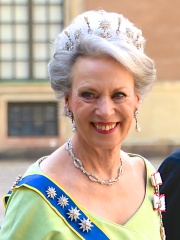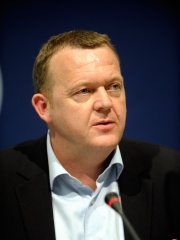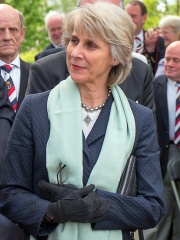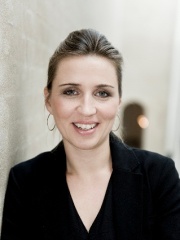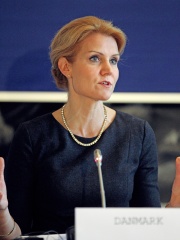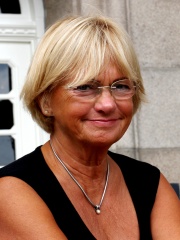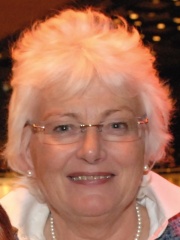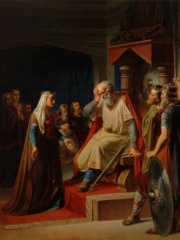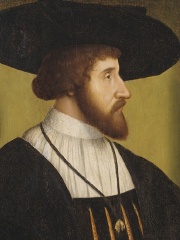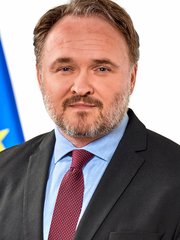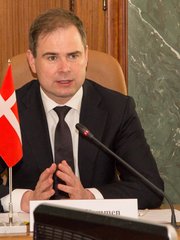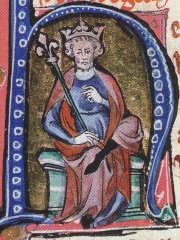
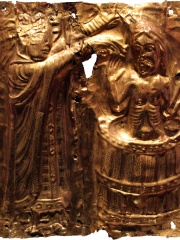
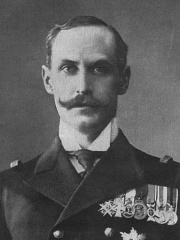
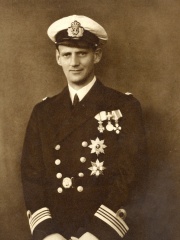
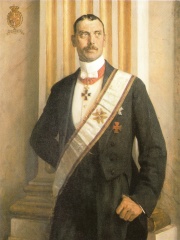
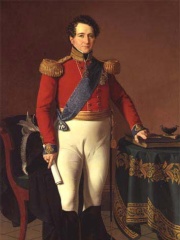
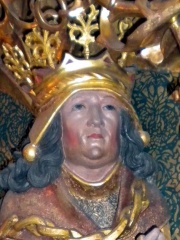
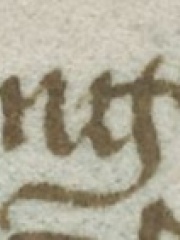
The Most Famous
POLITICIANS from Denmark
This page contains a list of the greatest Danish Politicians. The pantheon dataset contains 19,576 Politicians, 192 of which were born in Denmark. This makes Denmark the birth place of the 20th most number of Politicians behind Iraq, and Iran.
Top 10
The following people are considered by Pantheon to be the top 10 most legendary Danish Politicians of all time. This list of famous Danish Politicians is sorted by HPI (Historical Popularity Index), a metric that aggregates information on a biography's online popularity. Visit the rankings page to view the entire list of Danish Politicians.

1. Cnut the Great (995 - 1035)
With an HPI of 87.99, Cnut the Great is the most famous Danish Politician. His biography has been translated into 74 different languages on wikipedia.
Cnut ( kə-NYOOT; Old Norse: Knútr; c. 990 – 12 November 1035), also known as Canute and with the epithet the Great, was King of England from 1016, King of Denmark from 1018, and King of Norway from 1028 until his death in 1035. The three kingdoms united under Cnut's rule are referred to together as the North Sea Empire by historians. As a Danish prince, Cnut won the throne of England in 1016 in the wake of centuries of Viking activity in northwestern Europe. His later accession to the Danish throne in 1018 brought the crowns of England and Denmark together. Cnut sought to keep this power base by uniting Danes and English under cultural bonds of wealth and custom. After a decade of conflict with opponents in Scandinavia, Cnut claimed the crown of Norway in Trondheim in 1028. In 1031, Malcolm II of Scotland also submitted to him, though Anglo-Norse influence over Scotland was weak and ultimately did not last by the time of Cnut's death. Dominion of England lent the Danes an important link to the maritime zone between the islands of Great Britain and Ireland, where Cnut, like his father before him, had a strong interest and wielded much influence among the Norse–Gaels. Cnut's possession of England's dioceses and the continental Diocese of Denmark – with a claim laid upon it by the Holy Roman Empire's Archdiocese of Hamburg-Bremen – was a source of great prestige and leverage among the magnates of Christendom (gaining notable concessions such as one on the price of the pallium of his bishops, though they still had to travel to obtain the pallium, as well as on the tolls his people had to pay on the way to Rome). After his 1026 victory against Norway and Sweden, and on his way back from Rome where he attended the coronation of the Holy Roman Emperor, Cnut deemed himself "King of all England and Denmark and the Norwegians and of some of the Swedes" in a letter written for the benefit of his subjects. Medieval historian Norman Cantor called him "the most effective king in Anglo-Saxon history". He is popularly invoked in the context of the legend of King Canute and the tide.

2. Harald Bluetooth (935 - 986)
With an HPI of 83.17, Harald Bluetooth is the 2nd most famous Danish Politician. His biography has been translated into 55 different languages.
Harald "Bluetooth" Gormsson (Old Norse: Haraldr Blátǫnn Gormsson; Danish: Harald Blåtand Gormsen, died c. 985/86) was a king of Denmark and Norway. The son of King Gorm the Old and Thyra Dannebod, Harald ruled as king of Denmark from c. 958 – c. 986, introduced Christianity to Denmark and consolidated his rule over most of Jutland and Zealand. Harald's rule as king of Norway following the assassination of King Harald Greycloak of Norway was more tenuous, most likely lasting for no more than a few years in the 970s. Some sources say his son Sweyn Forkbeard forcibly deposed him from his Danish throne before his death.

3. Haakon VII of Norway (1872 - 1957)
With an HPI of 82.79, Haakon VII of Norway is the 3rd most famous Danish Politician. His biography has been translated into 66 different languages.
Haakon VII (Norwegian pronunciation: [ˈhôːkʊn]; born Prince Carl of Denmark; 3 August 1872 – 21 September 1957) was King of Norway from 1905 until his death in 1957. Having reigned for nearly 52 years, he was the second longest-reigning monarch in Norwegian history, after Christian IV. He was born in Copenhagen during the reign of his grandfather, King Christian IX of Denmark; he was named Carl at birth and was the second son of the Crown Prince and Crown Princess of Denmark (later King Frederick VIII and Queen Louise). Carl was educated at the Royal Danish Naval Academy and served in the Royal Danish Navy. After the 1905 dissolution of the union between Sweden and Norway, he was offered the Norwegian crown. Following a monarchy referendum, he accepted the offer and was formally elected King of Norway by the Storting and took the Old Norse name Haakon, thus ascended the throne as Haakon VII, becoming the first independent Norwegian monarch since Olav IV in 1387. As king, Haakon gained much sympathy from the Norwegian people. Although the Constitution of Norway vests the King with considerable executive powers, in practice Haakon confined himself to a representative and ceremonial role while rarely interfering in politics, a practice continued by his son and grandson. Norway was invaded by Nazi Germany in April 1940. Haakon rejected German demands to legitimise the Quisling regime's puppet government, vowing to abdicate rather than do so. He refused to abdicate after going into exile in Great Britain. As such, he played a pivotal role in uniting the Norwegian nation in its resistance to the invasion and the subsequent five-year-long occupation during the Second World War. He returned to Norway in June 1945 after the defeat of Germany. Haakon became King of Norway when his grandfather Christian IX was still reigning in Denmark, and before his father and elder brother became kings of Denmark. During his reign he saw his father Frederick VIII, his elder brother Christian X, and his nephew Frederik IX ascend the throne of Denmark in 1906, 1912, and 1947 respectively. Haakon died at the age of 85 in September 1957, after having reigned for nearly 52 years. He was succeeded by his only child and son, who ascended to the throne as Olav V.

4. Frederick IX of Denmark (1899 - 1972)
With an HPI of 81.91, Frederick IX of Denmark is the 4th most famous Danish Politician. His biography has been translated into 62 different languages.
Frederik IX (Christian Frederik Franz Michael Carl Valdemar Georg; 11 March 1899 – 14 January 1972) was King of Denmark from 1947 to 1972. Frederik was born into the House of Glücksburg during the reign of his great-grandfather King Christian IX. He was the first child of Prince Christian of Denmark and Princess Alexandrine of Mecklenburg-Schwerin (later King Christian X and Queen Alexandrine). He became crown prince when his father succeeded as king in 1912. As a young man, he was educated at the Royal Danish Naval Academy. In 1935, he married Princess Ingrid of Sweden. They had three daughters: Margrethe, Benedikte and Anne-Marie. During Nazi Germany's occupation of Denmark, Frederik acted as regent on behalf of his father from 1942 until 1943. Frederik became king on his father's death in April 1947. During Frederik's reign, Danish society changed rapidly, the welfare state was expanded and, as a consequence of the booming economy of the 1960s, women entered the labour market. The modernization brought new demands on the monarchy and Frederik's role as a constitutional monarch. Frederik died in 1972, and was succeeded by his eldest daughter, Margrethe II.
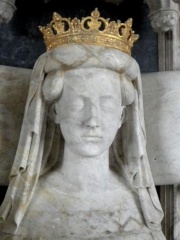
5. Margaret I of Denmark (1353 - 1412)
With an HPI of 81.56, Margaret I of Denmark is the 5th most famous Danish Politician. Her biography has been translated into 60 different languages.
Margaret I (Danish: Margrete Valdemarsdatter; March 1353 – 28 October 1412) was queen regnant of Denmark, Norway, and Sweden (which included Finland) from the late 1380s until her death, and the founder of the Kalmar Union that joined the Scandinavian kingdoms together for over a century. She had been queen consort of Norway from 1363 to 1380 and of Sweden from 1363 to 1364 by marriage to Haakon VI. Margaret was known as a wise, energetic and capable leader, who governed with "farsighted tact and caution", earning the nickname "Semiramis of the North". Also known famously and derisively as "King Breechless", one of several derogatory nicknames once thought to have been invented by her rival Albert, King of Sweden, she was also called "Lady King" by her subjects, widely used in recognition of her capabilities. Knut Gjerset calls her "the first great ruling queen in European history". The youngest daughter of Valdemar IV of Denmark, Margaret was born at Søborg Castle. She was a practical, patient administrator and diplomat, albeit one of high aspirations and a strong will, who intended to unite Scandinavia forever into one single entity with the strength to resist and compete against the might of the Hanseatic League. In 1363, aged ten, Margaret married Haakon VI. In 1370, they had a son, Olaf. Following the deaths of her husband and son, Margaret was proclaimed queen of the Scandinavian kingdoms. She was ultimately succeeded by a grandnephew, Erik of Pomerania. Although Erik came of age in 1401, Margaret continued for the remaining 11 years of her life to be sole ruler in all but name. Her regency marked the beginning of a Dano-Norwegian union which was to last for more than four centuries. Some Norwegian and Swedish historians have criticized Margaret for favouring Denmark and being too autocratic, though she is generally thought to have been highly regarded in Norway and respected in Denmark and Sweden. She was painted in a negative light in contemporary religious chronicles, as she had no qualms suppressing the Church to promote royal power. Margaret is known in Denmark as Margrethe I to distinguish her from Margrethe II.

6. Christian X of Denmark (1870 - 1947)
With an HPI of 81.17, Christian X of Denmark is the 6th most famous Danish Politician. His biography has been translated into 61 different languages.
Christian X (Danish: Christian Carl Frederik Albert Alexander Vilhelm; 26 September 1870 – 20 April 1947) was King of Denmark from 1912 until his death in 1947, and the only King of Iceland as Kristján X, holding the title as a result of the personal union between Denmark and independent Iceland between 1918 and 1944. He was a member of the House of Glücksburg, a branch of the House of Oldenburg, and the first monarch since King Frederick VII born into the Danish royal family; both his father and his grandfather were born as princes of a ducal family from Schleswig. Among his siblings was King Haakon VII of Norway. His son became Frederick IX of Denmark. Among his cousins were King George V of the United Kingdom, Emperor Nicholas II of Russia, and King Constantine I of Greece, while Queen Maud of Norway, was both his cousin and sister-in-law. His character has been described as authoritarian and he strongly stressed the importance of royal dignity and power. His reluctance to fully embrace democracy resulted in the Easter Crisis of 1920, in which he dismissed the democratically elected Social Liberal cabinet with which he disagreed, and installed one of his own choosing. This was in accordance with the letter of the constitution, but the principle of parliamentarianism had been considered a constitutional custom since 1901. Faced with mass demonstrations, a general strike organized by the Social Democrats, and the risk of the monarchy being overthrown, he was forced to accept that a monarch could not keep a government in office against the will of parliament as well as his reduced role as a symbolic head of state. During the German occupation of Denmark, Christian became a popular symbol of resistance, particularly because of the symbolic value of the fact that he rode every day through the streets of Copenhagen unaccompanied by guards. With a reign spanning two world wars, and his role as a rallying symbol for Danish national sentiment during the German occupation, he became one of the most popular Danish monarchs of modern times. In Iceland however, the Danish government's capitulation to the Germans was seen as an abandonment of the agreed defensive relationship that the Danish crown was to hold over the island. As head of state, Christian became deeply unpopular in Iceland, contributing to the country's redesignation as the modern Republic of Iceland.

7. Christian VIII of Denmark (1786 - 1848)
With an HPI of 78.63, Christian VIII of Denmark is the 7th most famous Danish Politician. His biography has been translated into 52 different languages.
Christian VIII (18 September 1786 – 20 January 1848) was King of Denmark from 1839 to 1848 and, as Christian Frederick, King of Norway in 1814. Christian Frederick was the eldest son of Hereditary Prince Frederick, a younger son of King Frederick V of Denmark and Norway. As his cousin Frederick VI had no sons, Christian Frederick was heir presumptive to the throne from 1808.

8. John, King of Denmark (1455 - 1513)
With an HPI of 78.17, John, King of Denmark is the 8th most famous Danish Politician. His biography has been translated into 48 different languages.
Hans, or sometimes called John (né Johannes; 2 February 1455 – 20 February 1513) was a Scandinavian monarch who ruled under the Kalmar Union. He was King of Denmark from 1482 to 1513, King of Norway from 1483 to 1513, and King of Sweden (where he has also been called Johan II) from 1497 to 1501. Additionally, from 1482 to 1513, he held the titles of Duke of Schleswig and Holstein, which he governed jointly with his brother, Frederick. The three most important political goals of King John were the restoration of the Kalmar Union, reduction of the dominance of the Hanseatic League, and the building of a strong Danish royal power.

9. Ivar the Boneless (900 - 873)
With an HPI of 77.97, Ivar the Boneless is the 9th most famous Danish Politician. His biography has been translated into 41 different languages.
Ivar the Boneless (Old Norse: Ívarr hinn Beinlausi [ˈiːˌwɑrː ˈhinː ˈbɛinˌlɔuse]; died c. 873), also known as Ivar Ragnarsson, was a Viking leader who led invasions into England and Ireland. According to the Tale of Ragnarr Loðbrók, he was the son of Aslaug and her husband Ragnar Loðbrok, and was the brother of Björn Ironside, Halvdan (or Hvitserk), Sigurd Snake-in-the-Eye, and Ragnvald. However, it is not known whether this is historically accurate. Ivar is sometimes regarded as the same person as Ímar, a Viking king of Dublin between 870 and 873. It is unclear why Ivar acquired the nickname "boneless". Some sagas claim that he was born with a skeletal condition which left him unable to walk, while others suggest that he was merely impotent.
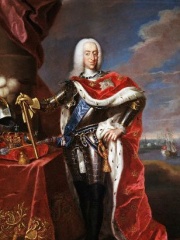
10. Christian VI of Denmark (1699 - 1746)
With an HPI of 77.47, Christian VI of Denmark is the 10th most famous Danish Politician. His biography has been translated into 48 different languages.
Christian VI (30 November 1699 – 6 August 1746) was King of Denmark and Norway from 1730 to 1746. The eldest surviving son of Frederick IV and Louise of Mecklenburg-Güstrow, he is considered one of Denmark-Norway's more anonymous kings, but he was a skilled politician, best known for his authoritarian regime. He was the first king of the Oldenburg dynasty to refrain from entering in any war. During his reign both compulsory confirmation (1736) and a public, nationwide school system (1739) were introduced. His chosen motto was "Deo et populo" (for God and the people).
People
Pantheon has 192 people classified as Danish politicians born between 501 and 1995. Of these 192, 47 (24.48%) of them are still alive today. The most famous living Danish politicians include Anders Fogh Rasmussen, Princess Benedikte of Denmark, and Poul Nyrup Rasmussen. The most famous deceased Danish politicians include Cnut the Great, Harald Bluetooth, and Haakon VII of Norway. As of April 2024, 18 new Danish politicians have been added to Pantheon including Frank Jensen, Dan Jørgensen, and Christel Schaldemose.
Living Danish Politicians
Go to all RankingsAnders Fogh Rasmussen
1953 - Present
HPI: 71.74
Princess Benedikte of Denmark
1944 - Present
HPI: 69.81
Poul Nyrup Rasmussen
1943 - Present
HPI: 65.36
Lars Løkke Rasmussen
1964 - Present
HPI: 64.52
Birgitte, Duchess of Gloucester
1946 - Present
HPI: 64.04
Mette Frederiksen
1977 - Present
HPI: 63.55
Helle Thorning-Schmidt
1966 - Present
HPI: 62.04
Margrethe Vestager
1968 - Present
HPI: 58.81
Mogens Lykketoft
1946 - Present
HPI: 57.62
Pia Kjærsgaard
1947 - Present
HPI: 57.09
Margrete Auken
1945 - Present
HPI: 53.77
Mariann Fischer Boel
1943 - Present
HPI: 53.23
Deceased Danish Politicians
Go to all RankingsCnut the Great
995 - 1035
HPI: 87.99
Harald Bluetooth
935 - 986
HPI: 83.17
Haakon VII of Norway
1872 - 1957
HPI: 82.79
Frederick IX of Denmark
1899 - 1972
HPI: 81.91
Margaret I of Denmark
1353 - 1412
HPI: 81.56
Christian X of Denmark
1870 - 1947
HPI: 81.17
Christian VIII of Denmark
1786 - 1848
HPI: 78.63
John, King of Denmark
1455 - 1513
HPI: 78.17
Ivar the Boneless
900 - 873
HPI: 77.97
Christian VI of Denmark
1699 - 1746
HPI: 77.47
Gorm the Old
900 - 958
HPI: 77.46
Christian II of Denmark
1481 - 1559
HPI: 77.34
Newly Added Danish Politicians (2025)
Go to all RankingsFrank Jensen
1961 - Present
HPI: 47.09
Dan Jørgensen
1975 - Present
HPI: 46.88
Christel Schaldemose
1967 - Present
HPI: 45.88
Troels Lund Poulsen
1976 - Present
HPI: 44.83
Ida Auken
1978 - Present
HPI: 42.13
Denice Klarskov
1986 - Present
HPI: 41.89
Nicolai Wammen
1971 - Present
HPI: 41.37
Nick Hækkerup
1968 - Present
HPI: 41.21
Peter Christensen
1975 - 2025
HPI: 40.72
Karen Hækkerup
1974 - Present
HPI: 39.88
Jesper Hansen
1980 - Present
HPI: 37.18
Dev1ce
1995 - Present
HPI: 37.17
Overlapping Lives
Which Politicians were alive at the same time? This visualization shows the lifespans of the 25 most globally memorable Politicians since 1700.


